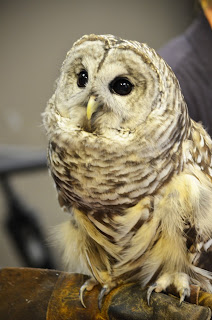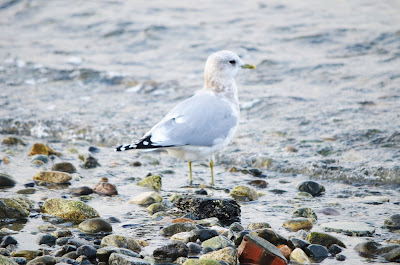Today I have a bitter sweet tale for you. It is about a kestrel and an owl.
Both were injured (hit by cars) but were brought to O.W.L. (Orphaned Wildlife) Rehabilitation Society and were treated for their injuries and are now living at the rescue centre. Neither was a candidate for release, let me tell you about them.
Both were injured (hit by cars) but were brought to O.W.L. (Orphaned Wildlife) Rehabilitation Society and were treated for their injuries and are now living at the rescue centre. Neither was a candidate for release, let me tell you about them.
From my camera:
Who me? I'm an owl, but lets talk about the kestrel first.
The kestrel's wing was so badly damaged that it will never fly again and it has lost the sight in one eye.
Both birds were at the Wildlife Unlimited Store (Broadway) recently, giving the public a rare opportunity to see them up close. Both birds were with experience handlers and were relaxed and spent the time observing the observers.
A kestrel is a member of the falcon family. This is an American Kestrel.
I would estimate the bird to be 6 to 8 inches tall.
They are able to hover about 10 to 20 metres in the air, by facing into even a slight breeze, and then swoop down when prey is spotted.
They eat small mammals, lizards, and birds and large insects.
Below you can see the damaged wing and eye quite clearly.
"The slender American Kestrel is roughly the size and shape of a Mourning Dove, although it has a larger head; longer, narrow wings; and long, square-tipped tail. In flight, the wings are often bent and the wingtips swept back." https://www.allaboutbirds.org/guide/American_Kestrel/id
"American Kestrels are pale when seen from below and warm, rusty brown spotted with black above, with a black band near the tip of the tail. Males have slate-blue wings; females’ wings are reddish brown. Both sexes have pairs of black vertical slashes on the sides of their pale faces—sometimes called a “mustache” and a “sideburn."" https://www.allaboutbirds.org/guide/American_Kestrel/id
"American Kestrels usually snatch their victims from the ground, though some catch quarry on the wing. They are gracefully buoyant in flight, and are small enough to get tossed around in the wind. When perched, kestrels often pump their tails as if they are trying to balance."
"American Kestrels occupy habitats ranging from deserts and grasslands to alpine meadows. You’re most likely to see them perching on telephone wires along roadsides, in open country with short vegetation and few trees." https://www.allaboutbirds.org/guide/American_Kestrel/id
These birds feed the young raptors that are brought in to OWL so that they don't get habituated to humans.
Here is a video of the kestrel:
Now here is the owl, a Barred Owl:
"Barred Owls are large, stocky owls with rounded heads, no ear tufts, and medium length, rounded tails." https://www.allaboutbirds.org/guide/Barred_Owl/id
This one also had a badly broken wing.
"Barred Owls are mottled brown and white overall, with dark brown, almost black, eyes. The under parts are mostly marked with vertical brown bars on a white background, while the upper breast is crossed with horizontal brown bars. The wings and tail are barred brown and white." https://www.allaboutbirds.org/guide/Barred_Owl/id
"Barred Owls roost quietly in forest trees during the day, though they can occasionally be heard calling in daylight hours. At night they hunt small animals, especially rodents, and give an instantly recognizable “Who cooks for you?” call." https://www.allaboutbirds.org/guide/Barred_Owl/id
"Barred Owls live in large, mature forests made up of both deciduous trees and evergreens, often near water. They nest in tree cavities. In the Northwest, Barred Owls have moved into old-growth coniferous forest, where they compete with the threatened Spotted Owl."
I have seen them in the University Endowment Lands Forest and heard stories of them swooping down on unsuspecting runners and walkers. They may confuse ponytailed hair with squirrels tails or they may just be a bit territorial. I have seen notices posted warning people to watch out for swooping owls in the late summer and early fall..
Here is a video of the barred owl and its distinctive call (“Who cooks for you?”) :
I hope you have enjoyed getting a close up look at these beautiful birds.
That's all the pictures I have for today, here is some information about O.W.L., use the link to visit their website.
About O.W.L.
From the website:
"The O.W.L. Orphaned Wildlife Rehabilitation Society is a nonprofit organization whose staff and volunteers are dedicated to education through conservation and the rehabilitation and release of injured and orphaned birds of prey. O.W.L. became a Society in January 1985 (Registration No. S-19879). O.W.L. is licensed through Fish and Wildlife, now known as the Ministry of Forests, Lands and Natural Resource Operations.
O.W.L. is on call seven days a week, twenty-four hours a day. Public tours are available every Saturday and Sunday from September to June and daily in July and August between 10:00am and 3:00pm.
The O.W.L. facility specializes in raptors (i.e. eagles, falcons, hawks and owls). Bird of prey patients at O.W.L. now number over six hundred, and are sent mainly from areas in British Columbia, as well as other provinces and the US. Primary and rehabilitative care for injured and orphaned birds is administered by staff. Surgeries are contributed by local clinics such as Huff Animal Hospital, Tsawwassen Animal Hospital, Richmond Animal Hospital and Dewdney Animal Hospital while other veterinary practices in the Lower Mainland aid in specialized procedures."
--------------------------------
I have two shows on now:
O.W.L. is on call seven days a week, twenty-four hours a day. Public tours are available every Saturday and Sunday from September to June and daily in July and August between 10:00am and 3:00pm.
The O.W.L. facility specializes in raptors (i.e. eagles, falcons, hawks and owls). Bird of prey patients at O.W.L. now number over six hundred, and are sent mainly from areas in British Columbia, as well as other provinces and the US. Primary and rehabilitative care for injured and orphaned birds is administered by staff. Surgeries are contributed by local clinics such as Huff Animal Hospital, Tsawwassen Animal Hospital, Richmond Animal Hospital and Dewdney Animal Hospital while other veterinary practices in the Lower Mainland aid in specialized procedures."
--------------------------------
I have two shows on now:
The Great Stuff show and sale at the Ferry Building and a Christmas Art show at Image West:
----------------------------------------------------
That is all I have for you this week.
Thanks for dropping by,
happy Wednesday, with whimsy,
Gillian

























































